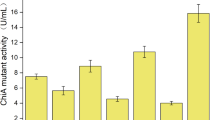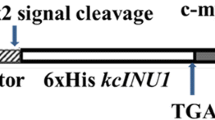Abstract
Lycopene beta-cyclase (β-LCY) is the key enzyme that modifies the linear lycopene molecule into cyclic β-carotene, an indispensable carotenoid of the photosynthetic apparatus and an important source of vitamin A in human and animal nutrition. Owing to its antioxidant activity, it is commercially used in the cosmetic and pharmaceutical industries, as well as an additive in foodstuffs. Therefore, β-carotene has a large share of the carotenoidic market. In this study, we used reverse transcription-polymerase chain reaction (RT-PCR) and rapid amplification of cDNA ends (RACE)-PCR to obtain and clone a cDNA copy of the gene Lyc-β from Ficus carica (Lyc-β Fc), which codes for the enzyme lycopene β-cyclase (β-LCY). Expression of this gene in Escherichia coli produced a single polypeptide of 56 kDa of weight, containing 496 amino acids, that was able to cycle both ends of the lycopene chain. Amino acid analysis revealed that the protein contained several conserved plant cyclase motifs. β-LCY activity was revealed by heterologous complementation analysis, with lycopene being converted to β-carotene as a result of the enzyme’s action. The β-LCY activity of the expressed protein was confirmed by high-performance liquid chromatography (HPLC) identification of the β-carotene. The lycopene to β-carotene conversion rate was 90%. The experiments carried out in this work showed that β-LYC is the enzyme responsible for converting lycopene, an acyclic carotene, to β-carotene, a bicyclic carotene in F. carica. Therefore, by cloning and expressing β-LCY in E. coli, we have obtained a new gene for β-carotene production or as part of the biosynthetic pathway of astaxanthin. So far, this is the first and only gene of the carotenoid pathway identified in F. carica.





Similar content being viewed by others
References
Ahrazem O, Rubio-Moraga A, Castillo R, Gomez-Gomez L (2009) The expression of chromoplast-specific lycopene beta cyclase gene is involved in the high production of saffron’s apocarotenoid precursors. J Exp Bot 61(1):105–119. doi:https://doi.org/10.1093/jxb/erp283
Alquezar B, Zacarias L, Rodrigo MJ (2009) Molecular and functional characterization of a novel chromoplast-specific lycopene β-cyclase from Citrus and its relation to lycopene accumulation. J Exp Bot 60(6):1783–1797. doi:https://doi.org/10.1093/jxb/erp048
Altschul SF, Gish W, Miller W, Myers EW, Lipman DJ (1990) Basic local alignment search tool. J Mol Biol 215(3):403–410
Ampomah-Dwamena C, McGhile T, Wibisono R, Montefiori M, Hellens RP, Allan AC (2009) The kiwifruit lycopene beta-cyclase plays a significant role in carotenoid accumulation in fruit. J Exp Bot 60(13):3765–3779. doi:https://doi.org/10.1093/jxb/erp218
Beyer P, Kröncke U, Nievelstein V (1991) On the mechanism of the lycopene isomerase/cyclase reaction in Narcissus pseudonarcissus L. chromoplasts. J Biol Chem 266(26):17072–17078
Bouvier F, d’Harlingue A, Camara B (1997) Molecular analysis of carotenoid cyclase inhibition. Arch Biochem Biophys 346(1):53–64
Bouvier F, Rahier A, Camara B (2005) Biogenesis, molecular regulation and function of plant isoprenoids. Prog Lipid Res 44(6):357–429
Britton G (1998) Overview of carotenoid biosynthesis. In: Britton G, Liaaen-Jensen S and Pfander H (eds) Carotenoids: biosynthesis and metabolism. Birkhäuser Verlag, Basel, Switzerland, pp 13–147
Cunningham FX (2002) Regulation of carotenoid synthesis and accumulation in plants. Pure Appl Chem 74:1409–1417
Cunningham FX, Sun Z, Chamovitz D, Hirschberg J, Gantt E (1994) Molecular structure and enzymatic function of lycopene cyclase from the cyanobacterium Synechococcus sp. strain PCC7942. Plant Cell 6:1107–1121
Cunningham FX, Pogson B, Sun Z, McDonald KA, DellaPenna D, Gantt E (1996) Functional analysis of the β and ε lycopene cyclase enzymes of Arabidopsis reveals a mechanism for control of cyclic carotenoid formation. Plant Cell 8(9):1613–1626
D’Ambrosio C, Giorio G, Marino I, Merendino A, Petrozza A, Salfi L, Stigliani A, Cellini F (2004) Virtually complete conversion of lycopene into beta-carotene in fruits of tomato plants transformed with the tomato lycopene beta cyclase (tlcy-b) cDNA. Plant Sci 166:207–214. doi:https://doi.org/10.1016/j.plantsci.2003.09.015
Daisuke U, Alexander VT, Frances HA (2005) Diversifying carotenoid biosynthetic pathways by directed evolution. Microbiol Mol Biol Rev 69(1):51–78. doi:https://doi.org/10.1128/MMBR.69.1.51-78.2005
DellaPenna D, Pogson BJ (2006) Vitamin synthesis in plants: tocopherols and carotenoids. Annu Rev Plant Biol 57(1):711–738
Emanuelsson O, Nielsen H, Von Heijne G (1999) ChloroP, a neural network-based method for predicting chloroplast transit peptides and their cleavage sites. Protein Sci 8(5):978–984
Frank H, Cogdell RJ (1993) Photochemistry and function of carotenoids in photosynthesis. In: Young AJ, Britton G (eds) Carotenoids and photosynthesis. Chapman & Hall, London, pp 253–326
Fraser PD, Bramley P (2004) The biosynthesis and nutritional uses of carotenoids. Prog Lipid Res 43(3):228–265
Gallagher CE, Cervantes M, Wurtzel ET (2003) Surrogate biochemistry: use of Escherichia coli to identify plant cDNAs that impact metabolic engineering of carotenoid accumulation. Appl Microbiol Biotechnol 60(6):713–719
Hirschberg J (2001) Carotenoid biosynthesis in flowering plants. Curr Opin Plant Biol 4(3):210–218
Hirschberg J, Cohen M, Harker M, Lotan T, Mann V, Pecker I (1997) Molecular genetics of the carotenoid biosynthesis pathway in plants and algae. Pure Appl Chem 69(10):2151–2158
Horton P, Ruban AV, Walters RG (1996) Regulation of light harvesting in green plants. Annu Rev Plant Physiol Plant Mol Biol 47:655–684
Hugueney P, Badillo A, Chen HC, Klein A, Hirschberg J, Camara B, Kuntz M (1995) Metabolism of cyclic carotenoids: a model for the alteration of this biosynthetic pathway in Capsicum annuum chromoplasts. Plant J 8(3):417–424
Jones DT (1999) Protein secondary structure prediction based on position-specific scoring matrices. J Mol Biol 292:195–202
Kimura M (1980) A simple method for estimating evolutionary rate of base substitutions through comparative studies of nucleotide sequences. J Mol Evol 16:111–120
Kumar S, Tamura K, Nei M (2004) MEGA3: integrated software for molecular evolutionary genetics analysis and sequence alignment. Briefings Bioinf 5:150–163
Laemmli UK (1970) Cleavage of structural proteins during the assembly of the head of bacteriophage T4. Nature (London, UK) 227:680–685
Lianju W, Weibin J, Kai M, Zhifeng L, Yelin W (2003) The production and research of fig (Ficus carica L.) in China. Acta Horticult 605:191–196
Melendez Martinez AJ, Vicario IM, Heredia FJ (2003) A routine high-perfomance liquid chromatography method for carotenoid determination in ultrafrozen orange juices. J Agric Food Chem 51:4219–4224
Misawa N, Satomi Y, Kondo K, Yokoyama A, Kajiwara S, Saito T, Ohtanai T, Miki W (1995) Structure and functional analysis of a marine bacterial carotenoid biosynthesis gene cluster and astaxanthin biosynthetic pathway proposed at the gene level. J Bacteriol 177:6575–6584
Misawa N, Shimada H (1998) Metabolic engineering for the production of carotenoids in non-carotenogenic bacteria and yeasts. J Biotechnol 59(3):169–181
Nakai K, Horton P (1999) PSORT: a program for detecting sorting signals in proteins and predicting their subcellular localization. Trends Biochem Sci 24(1):34–35
Park H, Kreunen SS, Cuttriss AJ, Dellapenna D, Pogson BJ (2002) Identification of the carotenoid isomerase provides insight into carotenoid biosynthesis, prolamellar body formation and photomorphogenesis. Plant Cell 14:321–332
Pecker I, Gabbay R, Cunningham FX, Hirschberg J (1996) Coning and characterization of the cDNA for lycopene beta-cyclase from tomato reveals decrease in its expression during fruit ripening. Plant Mol Biol 30:807–819
Peelman F, Labeur C, Vanloo B, Roosbeek S, Devaud C, Duverger N, Denefle P, Rosier M, Vandekerckhove J, Rosseneu M (2003) Characterization of the ABCA transporter subfamily: identification of prokaryotic and eukaryotic members, phylogeny and topology. J Mol Biol 325:259–274
Rodney AL (1994) Production of carotenoids by recombinant DNA technology. Pure Appl Chem 5(66):1057–1062
Rodrigo MJ, Marcos JF, Zacarías L (2004) Biochemical and molecular analysis of carotenoid biosynthesis in flavedo of orange (Citrus sinensis L.) during fruit development and maturation. J Agric Food Chem 52(22):6724–6731
Rodríguez Concepción M (2006) Early steps in isoprenoid biosynthesis: multilevel regulation of the supply of common precursors in plant cells. Phytochem Rev 1(5):1–15
Saitou N, Nei M (1987) The neighbor-joining method: a new method for reconstructing phylogenetic trees. Mol Biol Evol 4:406–425
Sandmann G (1994) Phytoene desaturase — genes, enzymes and phylogenetic aspects. J Plant Physiol 143(4–5):444–447
Sandmann G, Woods WS, Tuveson RW (1990) Identification of carotenoids in Erwinia herbicola and in a transformed Escherichia coli strain. FEMS Microbiol Lett 59(1–2):77–82
Sandmann G, Romer S, Fraser PD (2006) Understanding carotenoid metabolism as a necessity for genetic engineering of crop plants. Metab Eng 8(4):291–302
Schurr G, Misawa N, Sandmann G (1996) Expression, purification and properties of lycopene cyclase from Erwinia uredovora. Biochem J 315:869–874
Solomon A, Golubowicz S, Yablowicz Z, Grossman S, Bergman M, Gottlieb HE, Altman A, Kerem Z, Flaishman MA (2006) Antioxidant activities and anthocyanin content of fresh fruits of common fig (Ficus carica L.). J Agric Food Chem 54:7717–7723
Su Q, Rowley KG, Itsiopoulos C, O’Dea K (2002) Identification and quantitation of major carotenoids in selected components of the Mediterranean diet: green leafy vegetables, figs and olive oil. Eur J Clin Nutr 56:1149–1154
Teramoto M, Takaichi S, Inomata Y, Ikenaga H, Misawa N (2003) Structural and functional analysis of a lycopene beta-monocyclase gene isolated from a unique marine bacterium that produces myxol. FEBS Lett 545:120–126
Tian L, Magallanes-Lundback M, Musetti V, DellaPenna D (2003) Functional analysis of β- and ε-ring carotenoid hydroxylases in Arabidopsis. Plant Cell 15:1320–1332
Vinson JA (1999) The functional food properties of figs. Cereal Foods World 4:82–87
Vinson JA, Zubik L, Bose P, Samman N, Proch J (2005) Dried fruits: excellent in vitro and in vivo antioxidants. J Am Coll Nutr 24:44–50
Wirenga RK, Terpstra P, Hol WG (1986) Prediction of the occurrence of the ADP-binding β′β-fold in proteins, using an amino acid sequence fingerprint. J Mol Biol 187:101–107
Acknowledgements
J. A.-G. is the recipient of an AECID scholarship from the Spanish Foreign Affairs Ministry. The authors thank Dr. Norihiko Misawa (Research Institute for Bioresources and Biotechnology, Ishikawa Prefectural University) for the gift of plasmid pACCRT-EIB.
Author information
Authors and Affiliations
Corresponding author
Rights and permissions
About this article
Cite this article
Araya-Garay, J.M., Feijoo-Siota, L., Veiga-Crespo, P. et al. cDNA cloning of a novel gene codifying for the enzyme lycopene β-cyclase from Ficus carica and its expression in Escherichia coli . Appl Microbiol Biotechnol 92, 769–777 (2011). https://doi.org/10.1007/s00253-011-3488-8
Received:
Revised:
Accepted:
Published:
Issue Date:
DOI: https://doi.org/10.1007/s00253-011-3488-8




